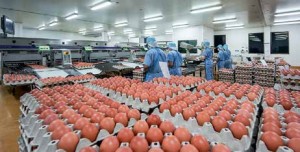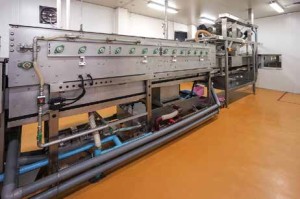The 400-million-baht renovation of a layer farm in Rattaphum district, Songkhla, will be completed in Q3, 2016, said Surachet Tongboonlorm, assistant vice-president.
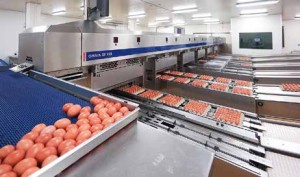
Egg grading facility at Rattanaphum, 30 km northeast of Hat Yai with 45,000 eggs/hour
capacity, serves customers within 300 km.
Efficiency and welfare are built into the design and workflow of the fully automatic operation. Drinking, feeding, lighting, ventilation, egg delivering and manure removal systems are all fully automated so that only two workers are able to handle 43,200 birds.
In the past, a single worker was thought to be capable of looking after no more than 6,000 birds, he noted.
There are four pullet houses, each holding 64,000 birds. The day-old layer chicks are delivered from Betagro’s breeder farm in Pakchong, Nakhon Ratchasima – 1,200 km away from the farm.
The pullets are brooded and grown for 15 weeks in the pullet unit. Then, they are moved to production houses located on the same compound 600 metres away. At that point, the bird weighs 1.2 kg, and flock uniformity is over 80%.
PRODUCTION UNITS
There are 10 pre-fab layer houses (17.1m x 100m x 3.8m). Walls and ceilings are insulated by sandwich panels with a thermal resistance rating of R-12.
Each house is installed with five rows of the latest enriched cages
(3m x 1m x 0.52m), and each row has four tiers of cages, with average spacing of 833 cm/bird.
Each cell contains 36 birds with four drinking nipples and 10 cm of eating space per bird.
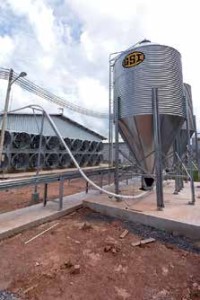
Pre-fab house (17.1m x 100m x 3.8m) with
two 13-tonne storage silos, with a 10 m space
between houses. Cooling pads are installed at
the front and on both sides of the house, for a
total cooling pad area of 148 sq m.
Two silos, each with 13 tonnes of storage capacity. Load cells monitor feed intake.
Cooling pads are installed in front and on both sides of the house, for a total cooling pad area of 148 sq m. Each house has 20 fans 50-inches in diameter that altogether create a maximum air speed of 2.4 m/second. Light intensity is 5-10 lux. A 350 KV backup electrical generator is wired to start up less than 60 seconds after a blackout.
Farm manager Prasit Ratanaphan said that this is the first project in Thailand that proves innovation innovation, welfare, productivity and investment cost can converge.
H&N Brown Nick is the breed of choice. For the first batch, hen-day percentage is currently running above 90% at 24 weeks of age. Peak production is expected at week 46, when average hen-day egg production reaches 97%. Total eggs/hen-housed is 159 pieces.
The hens are fed mash feed three times a day with average daily feed intake of 110 grams/bird. Average feed consumption/egg is 137 grams, with mortality below 0.2% per month. It is likely that eggs per hen housed at week 78 will rise above 340 pieces, he said.
The layer hens are vaccinated via drinking water on a monthly basis.
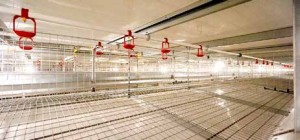
Valli Enriched cage (1m x 3m x 0.52m) holds 36 hens, with space/hen 833 sq cm/bird, twice
the size of a typical battery cage. Each cage contains four drinking nipples and 10 cm of eating
space.
The vaccination program covers Newcastle – live strain and infectious bronchitis. Blood samples are taken on a regular basis to test antibody titers in serum.
The vaccination program for pullets contains bursa, Newcastle, infectious bronchitis, mycoplasma, coryza and avian encephalomyelitis.
However, switching from the drinking waterbased system to a spraying method might improve vaccination efficacy, said Mr Prasit.
The manure is removed every day via manure belts and delivered to the farm’s biogas plant.
The Rattaphum project is the first layer farm to be equipped with a biogas recovery system. The
methane gas will serve as fuel for the electrical generator to generate power for internal use.
When the farm operates at full capacity, savings could be substantial, he said. The investment breakeven point is expected within less than five years, said Mr Surachet.
EGG GRADING
The company’s egg grading facility at Rattaphum with a capacity of 45,000 eggs/hour serves customers within a 300-km distance.
Nipon Noiwibol, production manager, said that cracks and defects have been brought down from 5-6% to 3%. The farm’s management team together with the QA/QC team are working to reduce defects to 2% before the end of 2017.
The eggs are delivered via a conveyor from the farm to the grading plant which is just 400 metres away. The eggs are brushed for 11 seconds in 40-60°C water containing chlorine at 50-100 ppm to remove dirt, then blow dried and UV disinfected. This operation is completed in the plant’s “low-care” zone.
The cleaned eggs are then moved to the “highcare” area via a hole in the wall which physically separates both areas. From there, they are moved through a candling desk to detect cracks and deformed eggs.
The defective eggs are rejected. Temperature in the high-care zone is 25°C. An egg storage room and more working space will be added to cope with increasing egg numbers when the farm runs at full capacity, said Mr Surachet.
The cleaned eggs which pass QC inspection are fed into an egg grading machine. The eggs are graded into six sizes, ranging from jumbo at over 70 grams on down to the peewee size, at around 35 grams, with five gram intervals in between.
The eggs are packed 10 to a box, 30 pieces to a tray and 5-tray packs for food service customers. Fresh eggs are delivered to customers every day. The eggs are subject to Haugh unit testing every week. The average Haugh unit upon delivery to customers is above 80% and yolk colour is above the DSM colour fan value of 12.
The eggs are regularly tested for salmonella contamination. Besides stringent biosecurity, feed quality and egg shell swabs are regularly monitored as a precaution to prevent salmonella contamination. Betagro plans to eventually put its entire supply chain inside a cold-chain to preserve freshness.
Certified by Thailand’s DLD and GMP, the plant also has a Q- Mark quality certificate. HACCP certification is expected by Q3, 2016.
Upon completion by the end of 2016, it will keep 430,000 hens at the farm along with 250,000 hens from its contract growers in Krabi. At full capacity, it will contribute 11% of the total egg supply in the south, up from 7%.
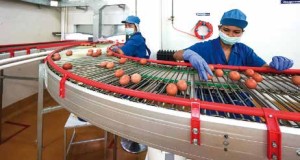
Low-care and high-care areas are physically separated by the wall. Workers detect cracked and
deformed eggs, while hairline cracks are further detected at the candling table.
The total operation will give Betagro sufficient eggs to supply its markets without additional eggs from outside the region.
Meanwhile, the marketing team is developing new marketing channels so that the increased output will not flood the market.
The eggs are marketed under the “Betagro” brand. Besides the food service segment and Betagro shops, some 35% of the fresh eggs are sold via wet markets. Egg grading operations and cold storage are about to be expanded, which will expedite future cold chain implementation.
Traditional channels such as wet markets are still important, yet distribution via its regional offices and Betagro outlets is increasing, with the current share at 35%.

